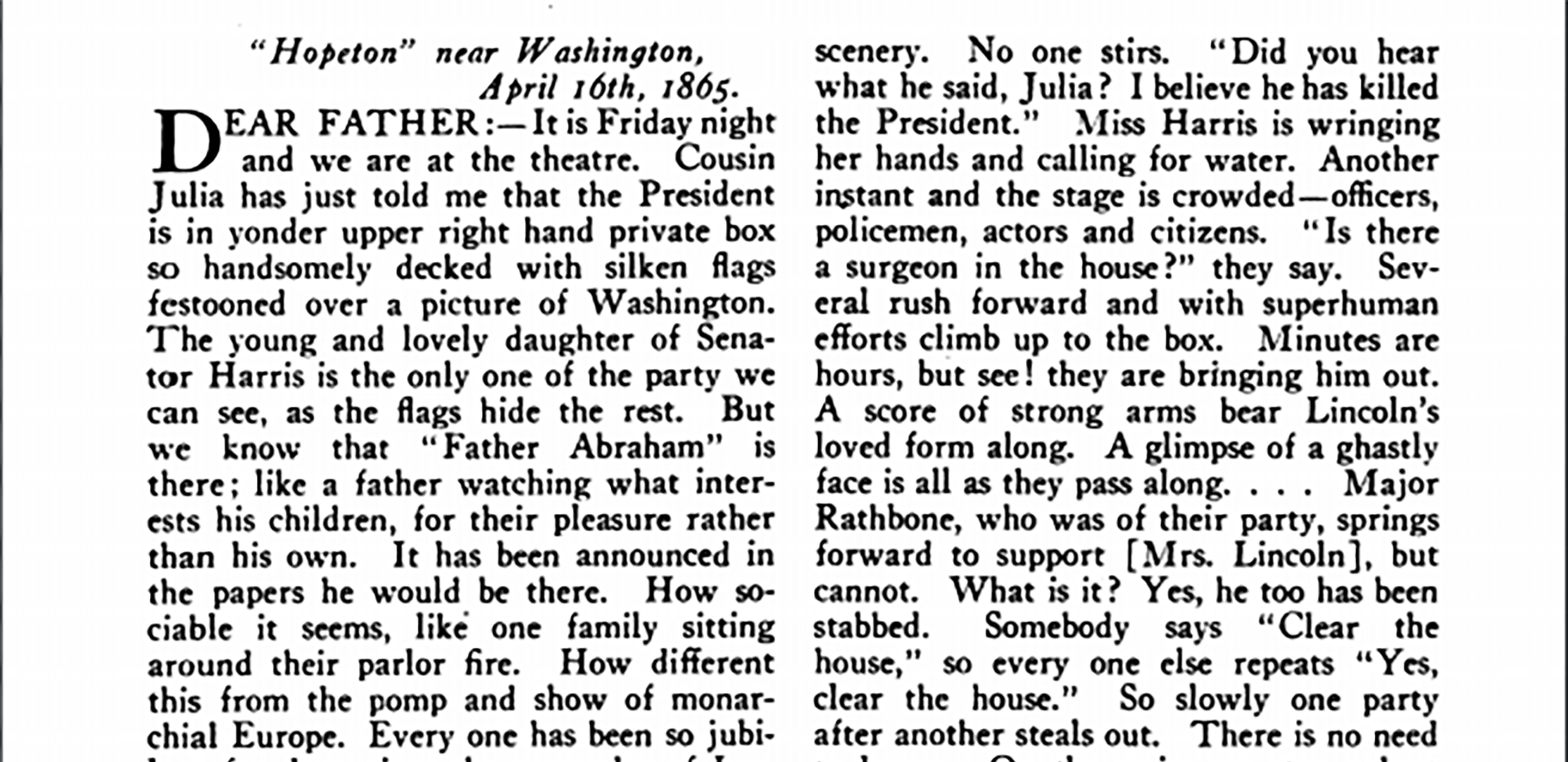
Narrative Writing: Using a Primary Source Memoir
In this lesson, students will close-read a narrative primary source (a letter from Julia Adelaide Shepard, an eyewitness to the assassination of President Abraham Lincoln) and use it as a mentor text for creating their own piece of narrative writing.
They will develop skills to distinguish facts from feelings in narrative writing and will strengthen their understanding of how details can be used to create and support a narrator’s point of view.
This lesson should be taught after students have developed background knowledge on the causes and major milestones of the Civil War, including the Emancipation Proclamation and the Confederate Army’s surrender at Appomattox.
Common Core Reading Standards
CCSS.ELA-LITERACY.RI.5.1:
Quote accurately from a text when explaining what the text says explicitly and when drawing inferences from the text.
CCSS.ELA-LITERACY.RI.5.2:
Determine a theme of a story, drama or poem from details in the text, including how characters in a story or drama respond to challenges or how the speaker in a poem reflects upon a topic; summarize the text.
CCSS.ELA-LITERACY.RI.5.6:
Analyze multiple accounts of the same event or topic, noting important similarities and differences in the point of view they represent.
Common Core Speaking and Listening Standards
CCSS.ELA-LITERACY.SL.5.1:
Engage effectively in a range of collaborative discussions (one-on-one, in groups and teacher-led) with diverse partners on Grade 5 topics and texts, building on others’ ideas and expressing their own clearly.
Common Core Writing Standards
CCSS.ELA-LITERACY.W.5.3:
Write narratives to develop real or imagined experiences or events using effective technique, descriptive details and clear event sequences.
CCSS.ELA-LITERACY.W.5.9:
Draw evidence from literary or informational texts to support analysis, reflection and research.
| Learning Objectives | Students will analyze a piece of narrative writing that is a primary source. Students will distinguish historical facts and events from thoughts and feelings in a narrative primary source. Students will use textual evidence from the original narrative primary source to make inferences about different historical points of view. Students will use textual evidence to compose short pieces of original narrative writing from different points of view. |
| Guiding Questions | How and why did Lincoln’s assassination take place? How did the assassination affect different people in different ways? Why is it important for us to consider different points of view about a historic event? How do narrators create a point of view in their writing? |
| Prepared by | Grade | Length |
| Leah Greenglass | Fifth Grade | Four Days |
What You Need
- Lincoln’s Assassination Told by an Eye Witness
A letter written by Julia Adelaide Shepard, an attendee of Ford’s Theatre on April 14, 1865 who wrote to her father on April 16, 1865 recounting the Lincoln Assassination - Think-Pair-Share
- Pick-a-Stick Method
- Reporter’s Notebook Thinking Routine
- Circle of Viewpoints Thinking Routine
Classroom Activities
- Lesson Activity One: First Read of “Lincoln’s Assassination Told by an Eye Witness” and Class Discussion
Students will hear a brief description of the Lincoln assassination, and will follow along, listening for facts and events, marking up their copies. Independently, they will answer text-based questions. - Lesson Activity Two: Second Read of “Lincoln’s Assassination Told by an Eye Witness” and Class Discussion
The class will read aloud the letter a second time. Students will follow along, listening for thoughts and feelings, marking up their copies. They will work in pairs to discuss their mark-ups and will independently respond to a writing prompt. - Lesson Activity Three: Introduction of Circle of Viewpoints Thinking Routine and Class Discussion
Students will review the characteristics of a memoir and participate in a Circle of Viewpoints routine. They will respond to the Circle of Viewpoints prompts in a Think-Pair-Share and independently develop a historical point of view to assassination. - Lesson Activity Four: Writing a Letter Inspired by an Historical Point of View
Students will write a letter telling the story of the Lincoln assassination from their created historical point of view. They will share aloud their writing in small groups, offering each other warm feedback.
